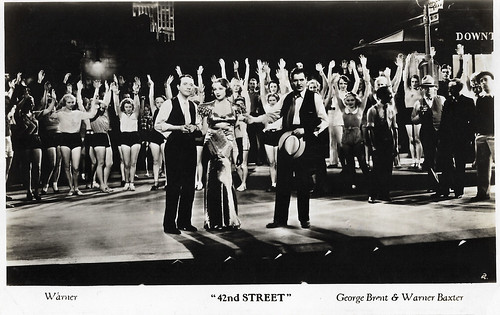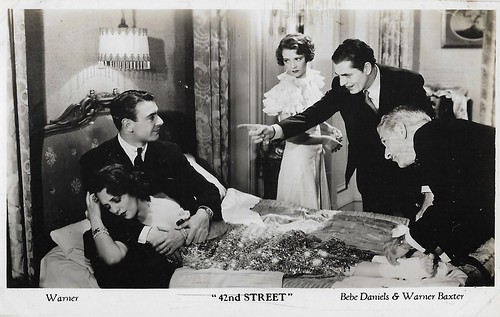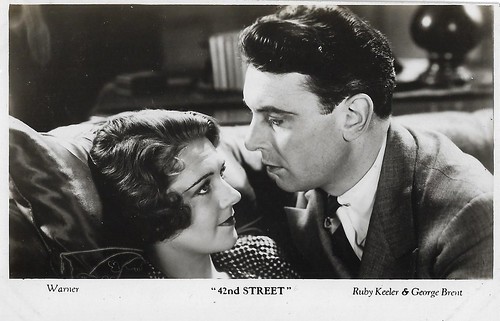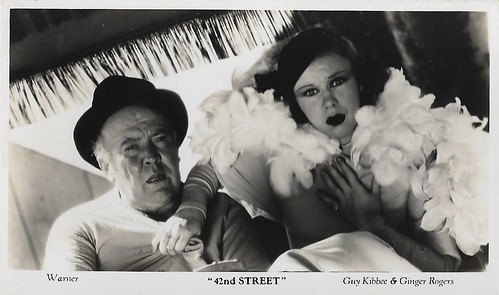During the early 1930s, the British magazine Film Weekly produced dozens of four card sets on popular films. Today a film special with a Film Weekly set for the classic film musical 42nd Street (Lloyd Bacon, 1933), produced by Warner Bros. Among the stars are Warren Baxter, Bebe Daniels, George Brent and the upcoming Ruby Keeler, Ginger Rogers and Dick Powell. The biggest star of the film however is dance director Busby Berkeley and his daring and dazzling camerawork. In 1934, the film was nominated for the Best Picture Oscar.

British postcard by Film Weekly. Photo: Warner Bros. Publicity postcard for 42nd Street (Lloyd Bacon, 1933) with George Brent, Bebe Daniels, and Warren Baxter.

British postcard by Film Weekly. Photo: Warner Bros. Publicity postcard for 42nd Street (Lloyd Bacon, 1933) with George Brent, Bebe Daniels, Ruby Keeler and Warren Baxter.
42nd Street (Lloyd Bacon, 1933) is the original depression-era back stage musical. Noted Broadway producers Jones (Robert McWade) and Barry (Ned Sparks) are putting on Pretty Lady, a musical starring Dorothy Brock (Bebe Daniels). She is involved with wealthy and sleazy sugar daddy Abner Dillon (Guy Kibbee), the show's financial backer, but while she is busy keeping him both hooked and at arm's length, she is secretly seeing her old vaudeville partner, out-of-work Pat Denning (George Brent).
Renowned Broadway producer/director Julian Marsh (Warner Baxter) is hired to put together the musical revue. Marsh is quite ill, and he must make his last show a hit, in order to have enough money to retire on. He is a difficult task master working long hours and continually pushing the cast to do better. When Brock breaks her ankle one of the chorus girls, naive newcomer Peggy Sawyer (Ruby Keeler) from Allentown, gets her big chance to be the star. The show's juvenile lead, Billy Lawler (Dick Powell), takes an immediate liking to Peggy. (In the original novel Julian and Billy are lovers. Since same-sex relationships were unacceptable in films by the moral standards of the era, the film substituted a romance between Billy and Peggy.)
What makes 42nd Street special is the dazzling and daring choreographed and filmed musical numbers by Busby Berkeley. He still overwhelms audiences with his larger-than-life lavish entertainment. Berkeley elaborately engineered colossal geometrically patterned dance routines. Berkeley evidently loved his chorus girls, and aimed his camera at their beautiful legs. When the chorus girls leave their dressing rooms and are coming down the stairs for opening night, Berkeley puts his camera under the stairs and shoots up their dresses as they pass. Further along, all the chorus girls are shown in a spectacular array of rhythmic movement, kaleidoscopic patterns of female flesh. In one musical number they form an arc and Berkeley tracks right through their legs all the way around the circle. Once the production code was strictly enforced in Hollywood after 1934, shots like this were never seen again.
42nd Street has three great musical number in the last twenty minutes of the film, 'You're Getting To Be A Habit With Me, 'Shuffle Off To Buffalo' and of course '42nd Street'. They were written by the powerhouse songwriting team of composer Harry Warren and lyricist Al Dubin. The script was written by Rian James and James Seymour, with Whitney Bolton, who was not credited, from the 1932 novel of the same name by Bradford Ropes. 42nd Street (1933) was Ruby Keeler's first film, and the first time that Busby Berkeley, Harry Warren and Al Dubin had worked for Warner Bros. Director Lloyd Bacon was not the first choice to direct – he replaced Mervyn LeRoy when LeRoy became ill. LeRoy was dating Ginger Rogers at the time, and had suggested to her that she take the role of the gold-digging chorus girl 'Anytime' Annie.
The story of 42nd Street is typical Warner Bros. in the Depression years: both hard-hitting and humorous. The film combines stunning musical numbers with a frank story about the desperation of people whose lives depend on putting on a hit show in trying times. Mordaunt Hall, the famous critic of The New York Times called the film "invariably entertaining" and, "The liveliest and one of the most tuneful screen musical comedies that has come out of Hollywood". 42nd Street has a tough urgency seldom found in musical films of the time. It struck a nerve with a world in crisis and became a huge hit. Warner already had a follow-up – Gold Diggers of 1933 (Mervyn LeRoy, Busby Berkeley, 1933) – in production before the film's release, and the success of both films permitted a higher budget and more elaborate production numbers in Warner's next follow-up, Footlight Parade (Lloyd Bacon, Busby Berkeley, 1933).

British postcard by Film Weekly. Photo: Warner Bros. Publicity postcard for 42nd Street (Lloyd Bacon, 1933) with Ruby Keeler and George Brent.

British postcard by Film Weekly. Photo: Warner Bros. Publicity postcard for 42nd Street (Lloyd Bacon, 1933) with Guy Kibbee and Ginger Rogers.
Sources: Emanuel Levy (emanuellevy.com), Wikipedia and IMDb.

British postcard by Film Weekly. Photo: Warner Bros. Publicity postcard for 42nd Street (Lloyd Bacon, 1933) with George Brent, Bebe Daniels, and Warren Baxter.

British postcard by Film Weekly. Photo: Warner Bros. Publicity postcard for 42nd Street (Lloyd Bacon, 1933) with George Brent, Bebe Daniels, Ruby Keeler and Warren Baxter.
Kaleidoscopic patterns of female flesh
42nd Street (Lloyd Bacon, 1933) is the original depression-era back stage musical. Noted Broadway producers Jones (Robert McWade) and Barry (Ned Sparks) are putting on Pretty Lady, a musical starring Dorothy Brock (Bebe Daniels). She is involved with wealthy and sleazy sugar daddy Abner Dillon (Guy Kibbee), the show's financial backer, but while she is busy keeping him both hooked and at arm's length, she is secretly seeing her old vaudeville partner, out-of-work Pat Denning (George Brent).
Renowned Broadway producer/director Julian Marsh (Warner Baxter) is hired to put together the musical revue. Marsh is quite ill, and he must make his last show a hit, in order to have enough money to retire on. He is a difficult task master working long hours and continually pushing the cast to do better. When Brock breaks her ankle one of the chorus girls, naive newcomer Peggy Sawyer (Ruby Keeler) from Allentown, gets her big chance to be the star. The show's juvenile lead, Billy Lawler (Dick Powell), takes an immediate liking to Peggy. (In the original novel Julian and Billy are lovers. Since same-sex relationships were unacceptable in films by the moral standards of the era, the film substituted a romance between Billy and Peggy.)
What makes 42nd Street special is the dazzling and daring choreographed and filmed musical numbers by Busby Berkeley. He still overwhelms audiences with his larger-than-life lavish entertainment. Berkeley elaborately engineered colossal geometrically patterned dance routines. Berkeley evidently loved his chorus girls, and aimed his camera at their beautiful legs. When the chorus girls leave their dressing rooms and are coming down the stairs for opening night, Berkeley puts his camera under the stairs and shoots up their dresses as they pass. Further along, all the chorus girls are shown in a spectacular array of rhythmic movement, kaleidoscopic patterns of female flesh. In one musical number they form an arc and Berkeley tracks right through their legs all the way around the circle. Once the production code was strictly enforced in Hollywood after 1934, shots like this were never seen again.
42nd Street has three great musical number in the last twenty minutes of the film, 'You're Getting To Be A Habit With Me, 'Shuffle Off To Buffalo' and of course '42nd Street'. They were written by the powerhouse songwriting team of composer Harry Warren and lyricist Al Dubin. The script was written by Rian James and James Seymour, with Whitney Bolton, who was not credited, from the 1932 novel of the same name by Bradford Ropes. 42nd Street (1933) was Ruby Keeler's first film, and the first time that Busby Berkeley, Harry Warren and Al Dubin had worked for Warner Bros. Director Lloyd Bacon was not the first choice to direct – he replaced Mervyn LeRoy when LeRoy became ill. LeRoy was dating Ginger Rogers at the time, and had suggested to her that she take the role of the gold-digging chorus girl 'Anytime' Annie.
The story of 42nd Street is typical Warner Bros. in the Depression years: both hard-hitting and humorous. The film combines stunning musical numbers with a frank story about the desperation of people whose lives depend on putting on a hit show in trying times. Mordaunt Hall, the famous critic of The New York Times called the film "invariably entertaining" and, "The liveliest and one of the most tuneful screen musical comedies that has come out of Hollywood". 42nd Street has a tough urgency seldom found in musical films of the time. It struck a nerve with a world in crisis and became a huge hit. Warner already had a follow-up – Gold Diggers of 1933 (Mervyn LeRoy, Busby Berkeley, 1933) – in production before the film's release, and the success of both films permitted a higher budget and more elaborate production numbers in Warner's next follow-up, Footlight Parade (Lloyd Bacon, Busby Berkeley, 1933).

British postcard by Film Weekly. Photo: Warner Bros. Publicity postcard for 42nd Street (Lloyd Bacon, 1933) with Ruby Keeler and George Brent.

British postcard by Film Weekly. Photo: Warner Bros. Publicity postcard for 42nd Street (Lloyd Bacon, 1933) with Guy Kibbee and Ginger Rogers.
Sources: Emanuel Levy (emanuellevy.com), Wikipedia and IMDb.
No comments:
Post a Comment